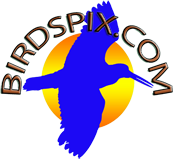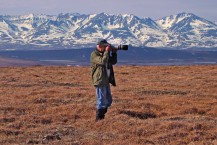From June 1 to June 8, I joined Wilderness Birding for excursions to Gambell and Nome, Alaska. The trip yielded 19 new North American species photographed (numbered in parentheses), as well as many new and better photographs of numerous previously seen species. Scenery photos of Gambell and Nome appear in an appended gallery.
The trip began on May 30 with a three-leg flight from Hartford to Anchorage via Chicago and Seattle. Early the next morning I picked up Bob Mustell, another of the Wilderness 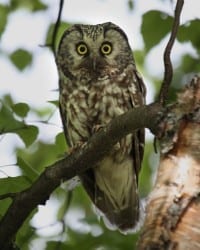 Birding group participants, and, following a word-of-mouth lead, we were fortunate enough to start the week on an especially high note with an extended encounter with a Boreal Owl (1), a life species for both of us, nesting in a wooded back yard less than fifteen miles outside of downtown Anchorage. Later we visited “Flat Top” high up in Chugach State Park with a panoramic view of the city, then Westchester Lagoon, and finally the Cook Inlet shore along the Knowles Trail, where we photographed several Hudsonian Godwits and a Surfbird.
Birding group participants, and, following a word-of-mouth lead, we were fortunate enough to start the week on an especially high note with an extended encounter with a Boreal Owl (1), a life species for both of us, nesting in a wooded back yard less than fifteen miles outside of downtown Anchorage. Later we visited “Flat Top” high up in Chugach State Park with a panoramic view of the city, then Westchester Lagoon, and finally the Cook Inlet shore along the Knowles Trail, where we photographed several Hudsonian Godwits and a Surfbird.
The adventure began in earnest the next morning when the group convened at 4 AM at the Anchorage Airport for the 6 AM flight to Nome. This is regular Alaska Airlines 737 jet service, and the flight made a stop in remote Kotzebue, my personal first visit north of the Arctic Circle. We arrived in Nome on time at 9 AM, but as is often the case in this part of the world, word came in at the Bering Air terminal that Gambell was shrouded in fog and no flights were possible until the weather changed, so we explored the area around the airport for some two hours before the go-ahead came through for the 45 minute flight to Gambell. Gambell is on the northwest tip of Saint Lawrence Island in the Bering Sea, some 40 miles from the Chukchi Peninsula of Siberia, which is the closest land, and a stone’s throw from the International Date Line, which passes between.
We were greeted in Gambell by our inimitable Wilderness Birding hosts Bob Dittrick and James Huntington, who wasted no time getting us settled in the group’s cozy two-story 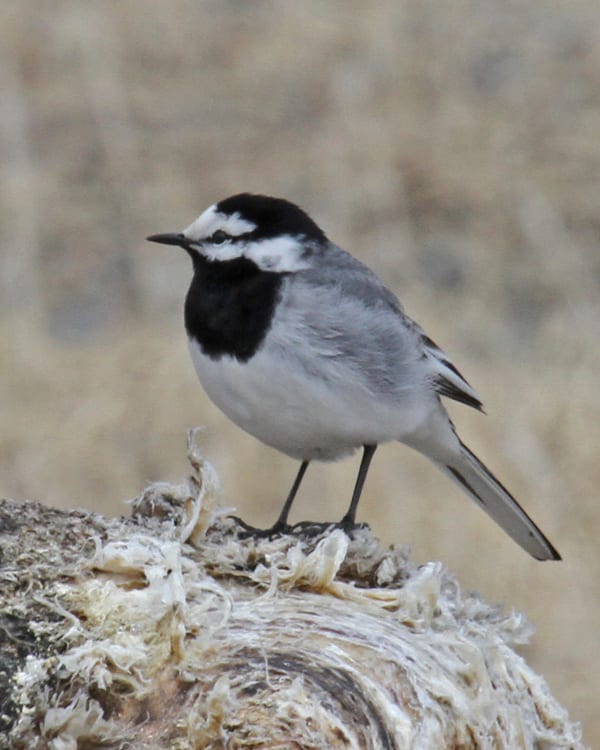 rented house at the edge of town. There are no cars in Gambell, just four-wheeler ATV’s, bicycles, and one’s own feet. The luggage went by ATV, we walked – and promptly logged our first species on Gambell, one of several White Wagtails (2). The notorious Gambell “pea gravel” unfortunately lives up to its reputation, as it gives way with every step and makes getting around on foot laborious, especially when wearing four or five layers of insulated clothing. There are now also a few new hard-packed gravel roads for the bicycles and ATV’s. The landscape is barren, windswept, and treeless, and the weather here can be very cold, blustery, and wet, but with the exception of the second morning, the elements themselves turned out not to be too much of a problem.
rented house at the edge of town. There are no cars in Gambell, just four-wheeler ATV’s, bicycles, and one’s own feet. The luggage went by ATV, we walked – and promptly logged our first species on Gambell, one of several White Wagtails (2). The notorious Gambell “pea gravel” unfortunately lives up to its reputation, as it gives way with every step and makes getting around on foot laborious, especially when wearing four or five layers of insulated clothing. There are now also a few new hard-packed gravel roads for the bicycles and ATV’s. The landscape is barren, windswept, and treeless, and the weather here can be very cold, blustery, and wet, but with the exception of the second morning, the elements themselves turned out not to be too much of a problem.
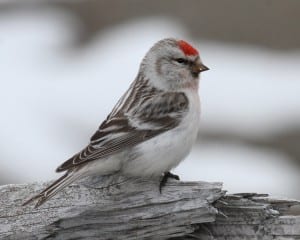 In the “boatyard” area around home base, we daily had several White Wagtails, and some beautifully pristine Hoary Redpolls. Lapland Longspurs and Snow Buntings are the most common passerines on Saint Lawrence Island, and Glaucous Gulls are the dominant large gull species. Black-legged Kittiwakes are frequent, and there are also a number of Vega Herring Gulls.
In the “boatyard” area around home base, we daily had several White Wagtails, and some beautifully pristine Hoary Redpolls. Lapland Longspurs and Snow Buntings are the most common passerines on Saint Lawrence Island, and Glaucous Gulls are the dominant large gull species. Black-legged Kittiwakes are frequent, and there are also a number of Vega Herring Gulls.
The second day, June 2, we explored the entire portion of the Gambell environs accessible to us, including the lake, the south marsh, the three boneyards, and of course the sea watch and the “point,” where an infrequent fly-by may be one’s only view of a given species. Many thousands of murres, auklets, and puffins conduct their daily fishing here, 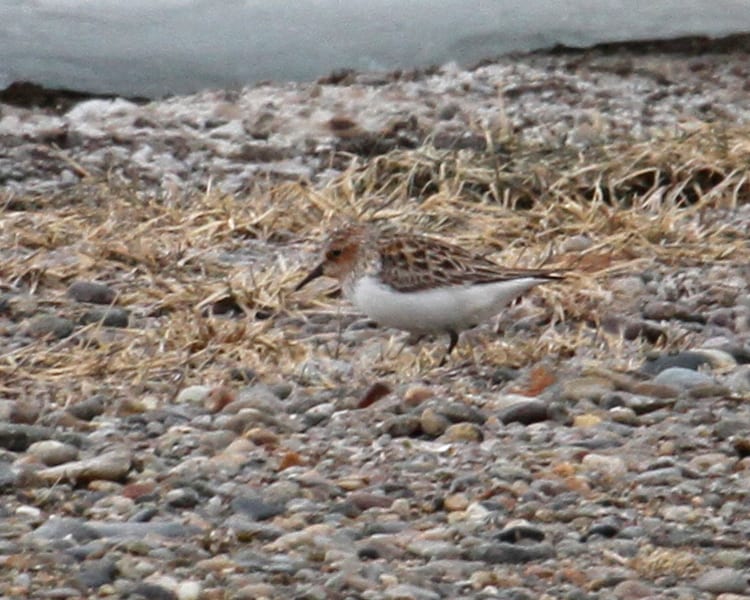 and Pelagic Cormorants, loons, geese, and ducks pass by less frequently so one has to be vigilant – and patient. Any shorebirds seen on Saint Lawrence Island (as well as Nome) will be in breeding plumage, unlike the duller nonbreeding versions often seen in the lower forty-eight. Today we had Western Sandpiper, Rock Sandpiper, Dunlin, numerous Red-necked Phalaropes, and a most welcome Red-necked Stint (3). Later in the afternoon a call came in over the walkie-talkie about Steller’s Eiders (4) at
and Pelagic Cormorants, loons, geese, and ducks pass by less frequently so one has to be vigilant – and patient. Any shorebirds seen on Saint Lawrence Island (as well as Nome) will be in breeding plumage, unlike the duller nonbreeding versions often seen in the lower forty-eight. Today we had Western Sandpiper, Rock Sandpiper, Dunlin, numerous Red-necked Phalaropes, and a most welcome Red-necked Stint (3). Later in the afternoon a call came in over the walkie-talkie about Steller’s Eiders (4) at 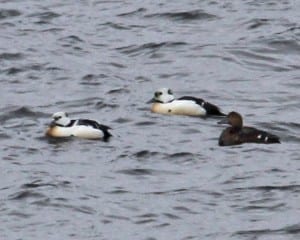 the point, so everyone made a beeline and it was a good thing we did, because this swimming group of three turned out to be the only Steller’s Eiders we would wind up seeing in Gambell. A short time later we observed a second-cycle Slaty-backed Gull perched on a small iceberg floating by in the current.
the point, so everyone made a beeline and it was a good thing we did, because this swimming group of three turned out to be the only Steller’s Eiders we would wind up seeing in Gambell. A short time later we observed a second-cycle Slaty-backed Gull perched on a small iceberg floating by in the current.
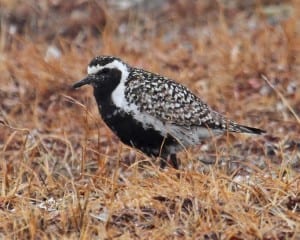 The next morning was miserably cold and wet. We made a futile pre-breakfast trip out to “the mountain” where all the murres and Least, Parakeet, and Crested Auklets roost, in order to look for the much rarer Dovekies, but the elements made the visibility too poor and the optics couldn’t be kept clear, so we had to give up. Later the weather improved a bit, providing sightings of a Northern Wheatear and Wandering
The next morning was miserably cold and wet. We made a futile pre-breakfast trip out to “the mountain” where all the murres and Least, Parakeet, and Crested Auklets roost, in order to look for the much rarer Dovekies, but the elements made the visibility too poor and the optics couldn’t be kept clear, so we had to give up. Later the weather improved a bit, providing sightings of a Northern Wheatear and Wandering 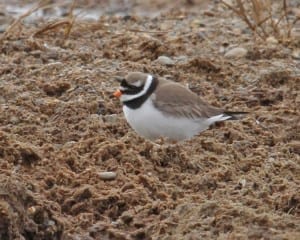 Tattler along the lake road, a Parasitic Jaeger sitting on a frozen pond, Long-billed Dowitchers, and a Pacific Golden-Plover (5) along the south marsh. Finally, a Common Ringed Plover (6) rounded out the day.
Tattler along the lake road, a Parasitic Jaeger sitting on a frozen pond, Long-billed Dowitchers, and a Pacific Golden-Plover (5) along the south marsh. Finally, a Common Ringed Plover (6) rounded out the day.
On June 4 the morning sea watch produced a few fly-bys of King Eiders, and one Emperor Goose (7) to complement all 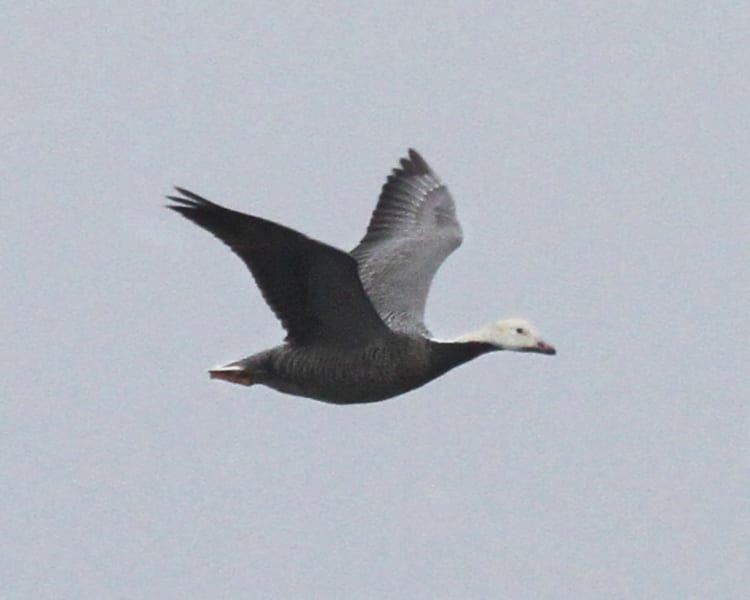 the usual suspects. That afternoon we had worked our way all the way around to the south side of the lake, and I spent some time photographing a Wandering Tattler. It was on the way toward the south marsh when a large shape suddenly appeared in the sky heading directly toward us from the south. There was only
the usual suspects. That afternoon we had worked our way all the way around to the south side of the lake, and I spent some time photographing a Wandering Tattler. It was on the way toward the south marsh when a large shape suddenly appeared in the sky heading directly toward us from the south. There was only 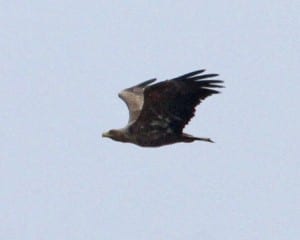 one thing this could be – a very rare White-tailed Eagle (8), a species with only a handful of North American records and a life bird for almost everyone in the group. Amazingly the eagle passed not too high over, of all places, exactly the spot where we happened to be positioned, before it circled higher in the thermals, allowing us to keep it in view for about two minutes altogether. The eagle caused much excitement, a lot of high fives, and probably the single most exceptional moment of the trip. The Rough-legged-Hawk that flew over a few minutes later was almost ignored.
one thing this could be – a very rare White-tailed Eagle (8), a species with only a handful of North American records and a life bird for almost everyone in the group. Amazingly the eagle passed not too high over, of all places, exactly the spot where we happened to be positioned, before it circled higher in the thermals, allowing us to keep it in view for about two minutes altogether. The eagle caused much excitement, a lot of high fives, and probably the single most exceptional moment of the trip. The Rough-legged-Hawk that flew over a few minutes later was almost ignored.
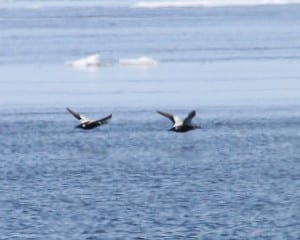 June 5 was the last day at Gambell, with a flight back to Nome at 5 PM. Time doesn’t mean much here this time of year, as it never gets dark, and the sun is present low in the sky all day. You go to bed when it’s light, and when you get up everything looks exactly the same, so the sun and the light alone give you little clue about what time of day it actually is, but it doesn’t matter anyway. At this morning’s sea watch there were some more King Eiders, and we had a fly-by of the only two (male) Spectacled Eiders (9) that we saw the entire time in Gambell.
June 5 was the last day at Gambell, with a flight back to Nome at 5 PM. Time doesn’t mean much here this time of year, as it never gets dark, and the sun is present low in the sky all day. You go to bed when it’s light, and when you get up everything looks exactly the same, so the sun and the light alone give you little clue about what time of day it actually is, but it doesn’t matter anyway. At this morning’s sea watch there were some more King Eiders, and we had a fly-by of the only two (male) Spectacled Eiders (9) that we saw the entire time in Gambell.
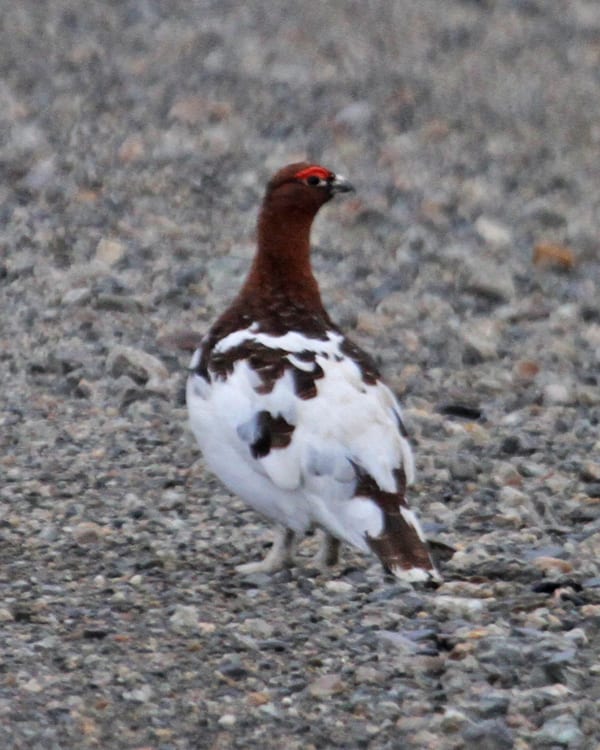 Our stay in Nome was in a quite luxurious home on the northern outskirts of town. On the short drive there from the airport we made a detour past a small pond to see a well-out-of-range breeding plumage Stilt Sandpiper, a quite rare bird for western Alaska. We spent a productive June 6 just north of Nome, and out on the spit between Norton Sound and Safety Sound. On Kougorak Road we encountered numerous Willow Ptarmigans (10), appropriately the state bird of Alaska. This
Our stay in Nome was in a quite luxurious home on the northern outskirts of town. On the short drive there from the airport we made a detour past a small pond to see a well-out-of-range breeding plumage Stilt Sandpiper, a quite rare bird for western Alaska. We spent a productive June 6 just north of Nome, and out on the spit between Norton Sound and Safety Sound. On Kougorak Road we encountered numerous Willow Ptarmigans (10), appropriately the state bird of Alaska. This 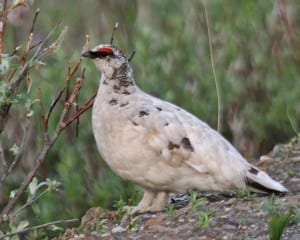 chicken-like bird is often seen in the middle of the road where it seems to be defending its territory even against an approaching vehicle, and not budging until the very last possible second. Along the edge of the same road there was also a single Rock Ptarmigan (11).
chicken-like bird is often seen in the middle of the road where it seems to be defending its territory even against an approaching vehicle, and not budging until the very last possible second. Along the edge of the same road there was also a single Rock Ptarmigan (11).
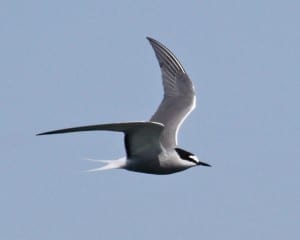 The ponds at the edge of Nome along the Council Road out to the spit are breeding grounds for numerous Red-throated Loons, resplendent in their Breeding plumage. The previous evening’s Stilt Sandpiper had already departed, but the Safety Sound bridge had lots of terns, mostly Arctic but a few Aleutian Terns (12) mixed in. We also had a single first-year Arctic Tern, distinguished by its white forehead, and very uncommon for the area as they usually winter in the southern hemisphere and don’t migrate north until they are adults. A small group of Black Scoters were out on Safety Sound. We planned to come back to the spit the following afternoon.
The ponds at the edge of Nome along the Council Road out to the spit are breeding grounds for numerous Red-throated Loons, resplendent in their Breeding plumage. The previous evening’s Stilt Sandpiper had already departed, but the Safety Sound bridge had lots of terns, mostly Arctic but a few Aleutian Terns (12) mixed in. We also had a single first-year Arctic Tern, distinguished by its white forehead, and very uncommon for the area as they usually winter in the southern hemisphere and don’t migrate north until they are adults. A small group of Black Scoters were out on Safety Sound. We planned to come back to the spit the following afternoon.
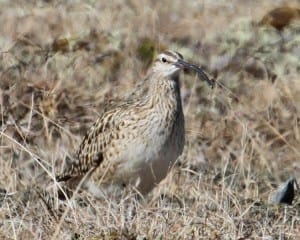 The morning of June 7 featured the signature excursion for the Bristle-thighed Curlew (13), perhaps the talisman bird of Nome and one of the main reasons birders make the Nome pilgrimage, as the single hilltop some 72 miles north of the town is the only reliable place to see this species in North America. Along the drive we had the unexpected surprise of a Northern Hawk-Owl perched in the open some 100 yards
The morning of June 7 featured the signature excursion for the Bristle-thighed Curlew (13), perhaps the talisman bird of Nome and one of the main reasons birders make the Nome pilgrimage, as the single hilltop some 72 miles north of the town is the only reliable place to see this species in North America. Along the drive we had the unexpected surprise of a Northern Hawk-Owl perched in the open some 100 yards 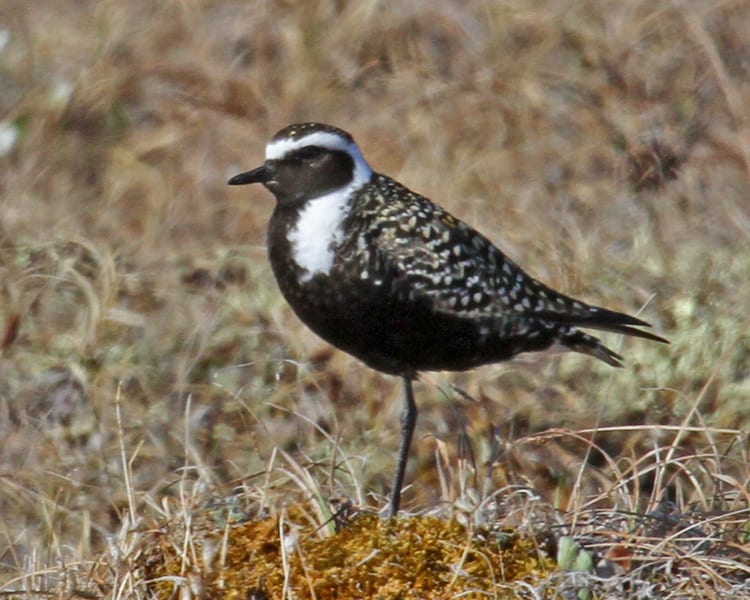 to the left of the road. Once at the base of the hill, a half-mile 700 foot climb is required to reach the curlew’s expansive grassy habitat. The hillside itself is composed entirely of tussocks – clumpy one to two foot grassy mounds which make footing treacherous, and where a single badly placed step can result in a sprained ankle (or worse) and a prompt end to one’s day (or trip), but with care everyone made it to the top OK. It turned out to be a spectacularly beautiful day, and everyone had prepared for cold and was thus overdressed, but no one expected the temperature in Nome, Alaska to reach 85 degrees!
to the left of the road. Once at the base of the hill, a half-mile 700 foot climb is required to reach the curlew’s expansive grassy habitat. The hillside itself is composed entirely of tussocks – clumpy one to two foot grassy mounds which make footing treacherous, and where a single badly placed step can result in a sprained ankle (or worse) and a prompt end to one’s day (or trip), but with care everyone made it to the top OK. It turned out to be a spectacularly beautiful day, and everyone had prepared for cold and was thus overdressed, but no one expected the temperature in Nome, Alaska to reach 85 degrees!
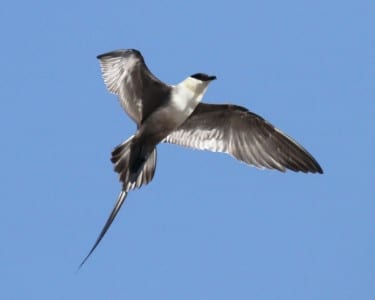 Once in the habitat, it took about twenty minutes before a Bristle-thighed Curlew was located, and we then spent about two hours on the hilltop trying to get good views and photographs, and in the same habitat we also were treated to a striking breeding-plumage American Golden-Plover, and a Long-tailed Jaeger kiting and doing various other aerial acrobatics against the backdrop of a brilliant blue sky and snow-capped mountains. It just doesn’t get much better than that.
Once in the habitat, it took about twenty minutes before a Bristle-thighed Curlew was located, and we then spent about two hours on the hilltop trying to get good views and photographs, and in the same habitat we also were treated to a striking breeding-plumage American Golden-Plover, and a Long-tailed Jaeger kiting and doing various other aerial acrobatics against the backdrop of a brilliant blue sky and snow-capped mountains. It just doesn’t get much better than that.
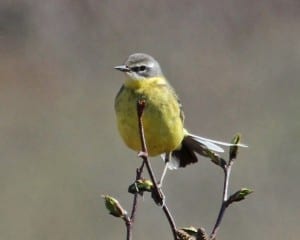 On the road back to Nome, we stopped for our picnic lunch at a bridge over the Kuzitrin River, where for company we had, among others, Cliff Swallows, a Blackpoll Warbler, a Bohemian Waxwing, and a cooperative Eastern Yellow Wagtail (14). Later we got several nice habitat views of
On the road back to Nome, we stopped for our picnic lunch at a bridge over the Kuzitrin River, where for company we had, among others, Cliff Swallows, a Blackpoll Warbler, a Bohemian Waxwing, and a cooperative Eastern Yellow Wagtail (14). Later we got several nice habitat views of 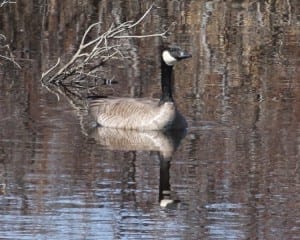 Cackling Goose (15), the taverni subspecies of which breeds in western Alaska, and, on various turnoffs off Kougarok Road, two different Gyrfalcon (16) nests, two Northern Wheatears, more Bohemian Waxwings, a singing Gray-cheeked Thrush, a Golden Eagle nest, and a fifteen-minute encounter with a
Cackling Goose (15), the taverni subspecies of which breeds in western Alaska, and, on various turnoffs off Kougarok Road, two different Gyrfalcon (16) nests, two Northern Wheatears, more Bohemian Waxwings, a singing Gray-cheeked Thrush, a Golden Eagle nest, and a fifteen-minute encounter with a 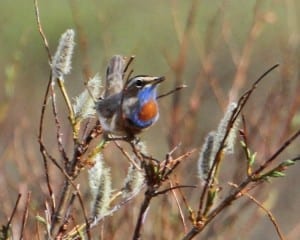 beautiful singing Bluethroat (17). This small Eurasian passerine will sing continuously and perfectly mimic the songs of all the other birds in its vicinity.
beautiful singing Bluethroat (17). This small Eurasian passerine will sing continuously and perfectly mimic the songs of all the other birds in its vicinity.
Before breakfast on June 8 we retraced about ten miles 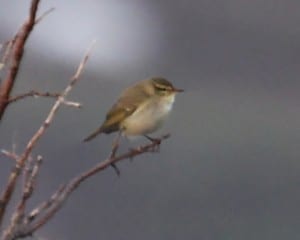 north to concentrate on singing Arctic Warblers (18) in the willows within 50 yards of the road itself. Every year they arrive in the area reliably right around June 6, and this year was no exception. The species is actually in the family of Eurasian leaf warblers, and not related to the familiar wood-warblers of the Americas. Before our 9 PM flight back to Anchorage,
north to concentrate on singing Arctic Warblers (18) in the willows within 50 yards of the road itself. Every year they arrive in the area reliably right around June 6, and this year was no exception. The species is actually in the family of Eurasian leaf warblers, and not related to the familiar wood-warblers of the Americas. Before our 9 PM flight back to Anchorage, 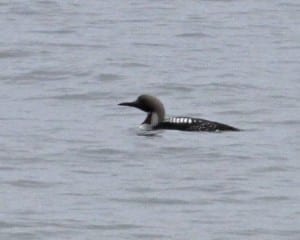 the rest of the day was back along the Safety Sound spit where, along with the usuals, we had several Arctic Loons (19) – albeit at a distance – a first-year male Spectacled Eider, several Common Eiders, a group of Tundra Swans, and a hunting Short-eared Owl.
the rest of the day was back along the Safety Sound spit where, along with the usuals, we had several Arctic Loons (19) – albeit at a distance – a first-year male Spectacled Eider, several Common Eiders, a group of Tundra Swans, and a hunting Short-eared Owl.
Bob Mustell and I spent June 9 in Anchorage mostly at Westchester Lagoon, where we had 2 Cackling Geese, 2 Lesser Canada Geese, 100 Greater Scaup, 7 Red-necked Grebes, a Bald Eagle nest, a flock of 47 Hudsonian Godwits and a single Long-billed Dowitcher on the island, some 40 Mew Gulls, and a rare-for-the-area Franklin’s Gull on the adjacent Cook Inlet flats. My flight departed at 5 PM, and with layovers in Seattle and Dallas, I didn’t land back in Hartford until noon the following day.
The trip was a great success, with 19 new North American species, and just one target species having been missed – that being Yellow-billed Loon. Our Wilderness Birding guides in Gambell, Bob Dittrick and James Huntington went the extra mile to make everyone’s experience as enjoyable and carefree as humanly possible, and Aaron Lang was every bit as able, knowledgeable, and helpful in Nome. For anyone planning an Alaska trip, I could not possibly recommend Wilderness Birding any higher. Also, sometimes a group can have a “party-pooper” type that just gives everybody a hard time, but the Gambell tour was just an especially convivial group with excellent joyful comraderie, lots of great laughs, and nothing but good fun the whole time.
